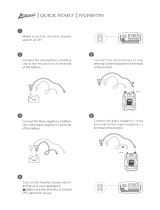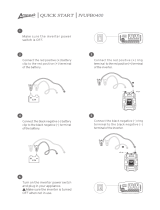
10
4. As the battery becomes nearly discharged, or empty, a low
voltage warning will sound. This will give you time to shut
down a computer, for example. If this warning is ignored, the
inverter will switch off automatically a few minutes later to
prevent battery damage. (See section below for full details.)
5. Fully recharge xPower300s battery as soon as possible after
each use. See Section 7.
Automatic Protection: Overload, Overheating
and Low Battery
xPower300 has built-in protection against output overload and
from overheating. If an AC product rated higher than 300
watts (or which draws excessive surge power at start up) is
connected, or if the inverter exceeds a safe temperature, it will
automatically shut down. The green POWER light will go off
and the red FAULT light will switch on. To reset, unplug the
product and turn the AC Outlets Switch off for 5 seconds,
then turn it back on. Normal operation should resume. If not,
turn the AC Outlets Switch off again and allow xPower300 to
cool for several minutes. While AC power is off, press the
Battery Status Switch to make sure the charge level is
sufficient.
If the battery is allowed to discharge excessively, damage may
occur. To prevent this, the AC inverter has a built-in audible
warning that alerts you when the battery is nearly discharged
and it is time to recharge xPower300. If this warning is ignored,
the inverter will automatically switch off and the red FAULT
light will illuminate when the battery reaches empty.
xPower300s internal fan will continue running and the FAULT
light will remain on until inverter is turned off. Promptly
recharge the battery. See Section 7.
Interference with Electronic Equipment
Buzzing Sound in Audio Systems
Some inexpensive stereo systems and boom-boxes will emit
a buzzing sound from their loudspeakers when operating from
the AC output of xPower300. This is because the power
supply in the equipment does not adequately filter the
modified sine wave produced by xPower300s AC inverter.
Unless the stereo can be operated directly from xPower300s
12-volt DC Power Socket, the only solution is a sound system
with a higher quality internal power filter.

































